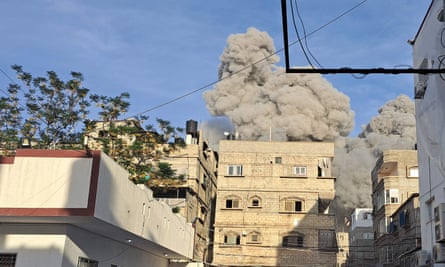More than 100 Palestinians in Gaza were reported killed on Wednesday as Israeli forces continued attacking across the strip from land, sea and air hours after the agreement for a ceasefire to begin on Thursday.
Wafa, a Palestinian news agency, said 81 people had been killed since midnight as houses were targeted in the centre of the strip. A further 60 were believed to be dead after bombing in and around the Jabaliya refugee camp in the north.
Deadly bombing was also reported at the al-Nuseirat refugee camp, killing nine people. Casualty figures are difficult to verify given the ongoing fighting, although initial reports often turn out to be underestimates until those missing are accounted for.
The ceasefire is likely to begin on Thursday morning while Israel completes various formalities including notifying which 300 Palestinian prisoners it could release. An initial 150 are expected to be freed in the four days, in return for the release of 50 hostages held by Hamas and other groups. But there was little sign of a slowdown in the fighting on Wednesday.
Fighting continued around two hospitals in the north of the Gaza Strip, the Indonesia hospital and the Kamal Adwan hospital in Beit Lahiya, amid IDF demands that they be evacuated so the military can take control.

Medhat Abass, the director general of the health ministry in Gaza, said: “We fear for the lives of those inside Kamal Adwan, al-Awda and the Indonesian hospitals,” and earlier described the Indonesia hospital as “besieged”.
Abass distributed a message from Dr Essay Nabhan, the head of the nursing department, who said “the hospital was transformed from a centre providing medical services into a mass grave. There are corpses in all of the departments, and we lost many lives due to the lack of supplies.”
Sixty corpses lay in front of the morgue, they added. There were plans to bury them inside the grounds of the hospital, as it was unsafe to leave the premises where hundreds sheltered fearfully sheltered inside.
At the Kamal Adwan hospital in Beit Lahiya, the lone hospital in operation at the northern part of the enclave, the director, Ahmed al-Kahlout, told Al Jazeera that “shelling and bombardment are increasing everywhere in the vicinity of the hospital”.
The hospital had received more than 60 bodies with over 200 injured since last night, he added. “The medical teams are very tired. We don’t have a single drop of fuel. We work in the dark using handheld searchlights,” he said.
In another message distributed by the health ministry, Kahlout said the hospital was using cooking oil rather than diesel to run the hospital’s generators, and an ambulance targeting the wounded had been struck near the hospital grounds.
Israel confirmed it would continue to attack as it had done until the ceasefire took effect, although a spokesperson for the Israel Defense Forces said its start timing was uncertain and could be later on Thursday.
Lt Col Richard Hecht, the IDF’s international spokesperson, told a briefing: “We still have probably, maybe a day-plus before this thing matures, and things can happen in that day. And I assume today is going to be a day of fighting in Gaza.”
Media reports in Egypt and Israel suggested that a truce would come into effect at 10am tomorrow (8am GMT) but Hecht said he could not confirm any timings or details at Wednesday lunchtime. “We still haven’t got the nitty gritty of this framework,” he added.
Israel’s troops have pressed forward on the ground in an effort to gain as much control of the territory in northern Gaza. Its forces encircled Jabaliya on Tuesday, where fighting was continuing, and on Wednesday called on residents of its old city and nearby Shuja’iya neighbourhood to evacuate south before 4pm.
Attacks were coming from the sea as well as by air and land. The IDF released black and white footage showing bombing from air and sea, plus a video of Israeli soldiers operating in a shattered urban landscape, clearing buildings at gunpoint and calling in airstrikes to attack nearby compounds.
The IDF describes the ceasefire as an “operational pause”, in line with comments overnight from the Israeli prime minister, Benjamin Netanyahu – a clear attempt to hint that bombing could resume after the hostage exchange is completed. “Our terminology is not ceasefire, our terminology is an operational pause,” Hecht said.
Despite the intensity of the fighting, evacuations were also taking place from medical facilities. Israel is demanding that the hospitals, overcrowded with patients and others seeking safety, be evacuated, arguing that Hamas tunnels and command points are often based below them.
Gaza’s health ministry said it was able to evacuate 320 of the wounded and their families from the Indonesia hospital to southern Gaza on Wednesday using ambulances.
The remaining wounded were also evacuated from al-Shifa hospital, at the southern end of Gaza City, using 14 ambulances sent by the Palestinian Red Crescent and accompanied by the UN and Médecins Sans Frontières. Several days of evacuations have been taking place from al-Shifa, which was surrounded and raided by Israeli forces last week.